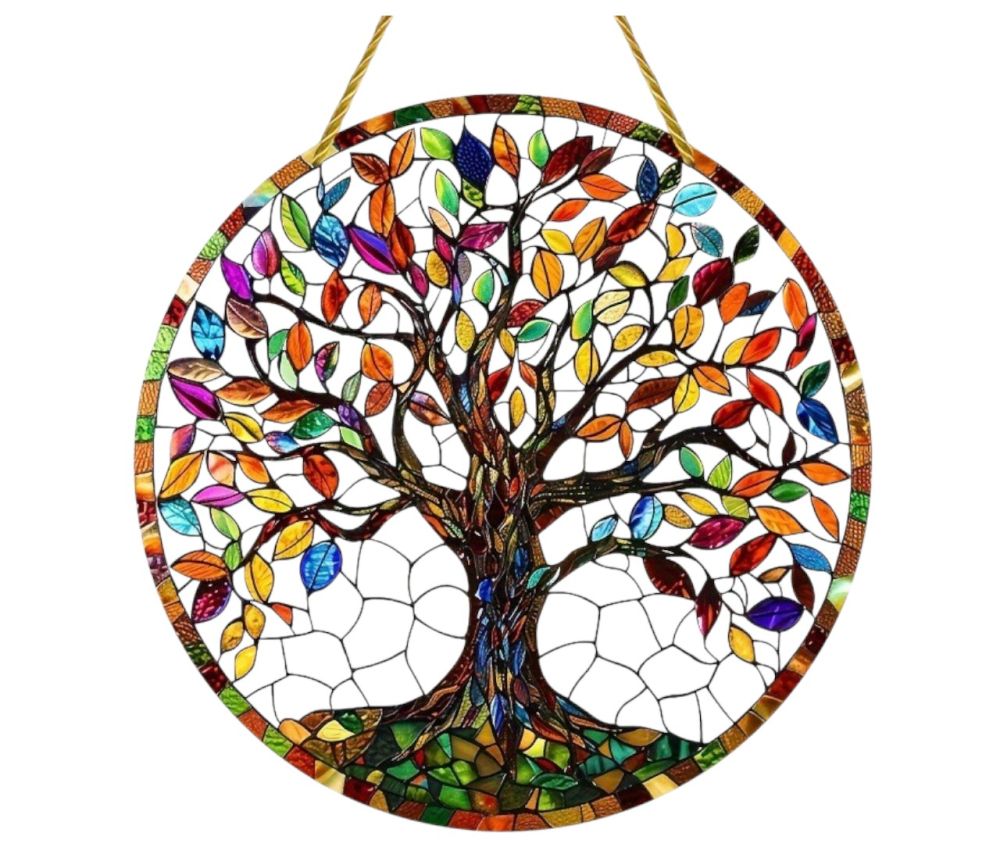We use cookies to make your experience better.
TimmersGems has a new website, existing customers also need to register again.
Hanger Tree of Life, made of very colorful acrylic material (15 cm in diameter).
Tree of Life pendant, made of very colorful acrylic material (15 cm doorsnede). Beautiful pendant that works well, for example, for a window.
Availability:
In stock
SKU
121788
The Biblical Tree of Life (Hebrew: עץ החיים; Etz haChayim) is mentioned in the Book of Genesis in verse 2:9 as the tree that, along with the Tree of Knowledge of Good and Evil, was planted by God in the Garden of Eden (Paradise) and whose fruits grant eternal life (immortality). After Adam and Eve had eaten from the tree of the knowledge of good and evil, the Bible writes that both were banished from the Garden of Eden to prevent them from eating from the fruits of the tree of life: "Then the LORD God said, 'The man has now become like one of us, knowing good and evil.'" Now I want to prevent him from also picking fruit from the tree of life, for if he were to eat it, he would live forever. — (NBV, Gen 3:22),According to the biblical story, Adam and Eve were thus separated from the tree of life and made mortal. In the Christian New Testament, this banishment from the Garden of Eden is compensated by the 'planting' of the new tree of life (Jesus) on the side of humanity. In the book of Revelation by John, the Koine Greek phrase xylon zoës (ξύλov ζωής) is used three times (2:7, 22:2, and 22:19), which is literally translated as 'tree of life' or 'tree of the life' in Dutch translations (22:19 is also translated as 'book of life' in some translations). The 'tree of life' is used multiple times in the Book of Proverbs in connection with Wisdom. As an image, it describes the value of wisdom. Wisdom is a tree of life for those who embrace it. (Spr. 3,18). A righteous person plants a tree of life. (Spr. 11,30). Fulfilled desire (as opposed to unfulfilled hope) is a tree of life. (Spr. 13,12). Calm words (as opposed to a deceitful tongue) are a tree of life. (Spr. 15,4). The writer of Proverbs seems to show a fondness for the image of the tree of life, but it is never explicitly stated. The image as such probably possesses sufficient significance for the writer. The Tree of Life is depicted in various examples of sacred geometry and forms a central point in Kabbalah (the mystical study of the Torah), where it is represented as the sephirot. The Germanic Tree of Life. The Irminsul was an important sanctuary for the Saxons of the eighth century AD with presumably great symbolic significance. It is mentioned and briefly described in the Annales regni Francorum, the Translatio St. Alexandri by Rudolf of Fulda, and in the Gesta Hammaburgensis ecclesiae pontificum (Book I, chapter 8) by Adam of Bremen. Both of the latter use exactly the same words and describe the Irminsul as a large, upright wooden pillar that, according to the Saxons, supported the entire world. Adam of Bremen, however, says that he took the information from Einhard (c. 770-841). However, his work has not been preserved. In Einhard's words according to Adam of Bremen: They also worshipped a wooden trunk of no small size, erected upright under the open sky, calling it Irminsul in their native tongue, which in Latin is called universalis columna, as if supporting everything. Translated, this means: They also used to worship a wooden trunk of no small size that was erected upright under the open sky, which they called Irminsul in the language of their homeland, which in Latin is called universalis columna (= the universal column), which as it were supported everything. The Kabbalistic Tree of Life is a model with which Hermetic Kabbalists symbolically represent the entire universe and its creation. This Tree of Life has a different form than the one known to Jewish Kabbalists. The first publication in which this Tree of Life appeared was Athanasius Kircher's Oedipus Aegypticus from 1652. Robert Fludd adopted this diagram in an adapted form in his Complete Works from 1617.
| Dimensions | 150mm |
|---|---|
| Country of Manufacture | China |












